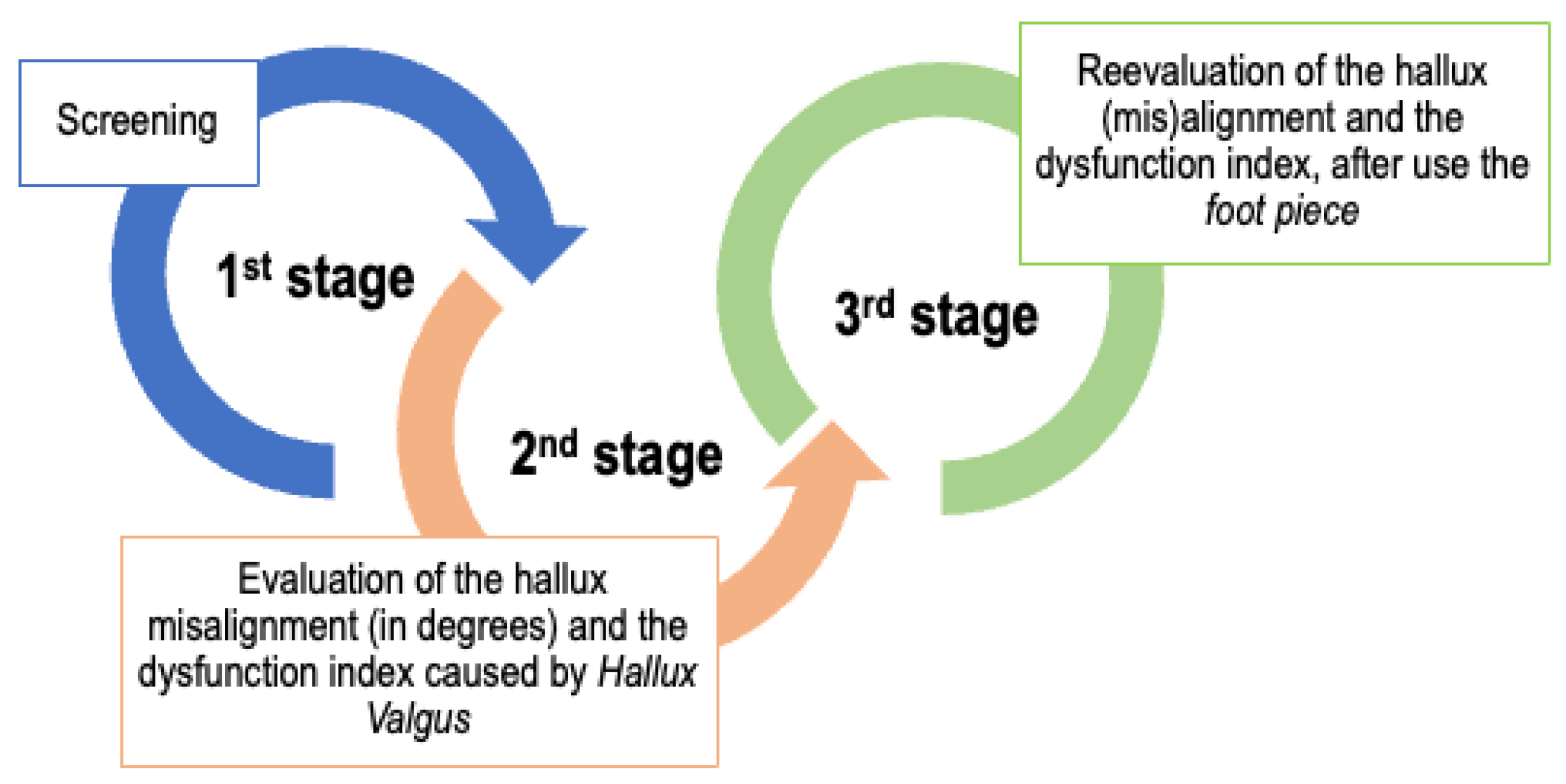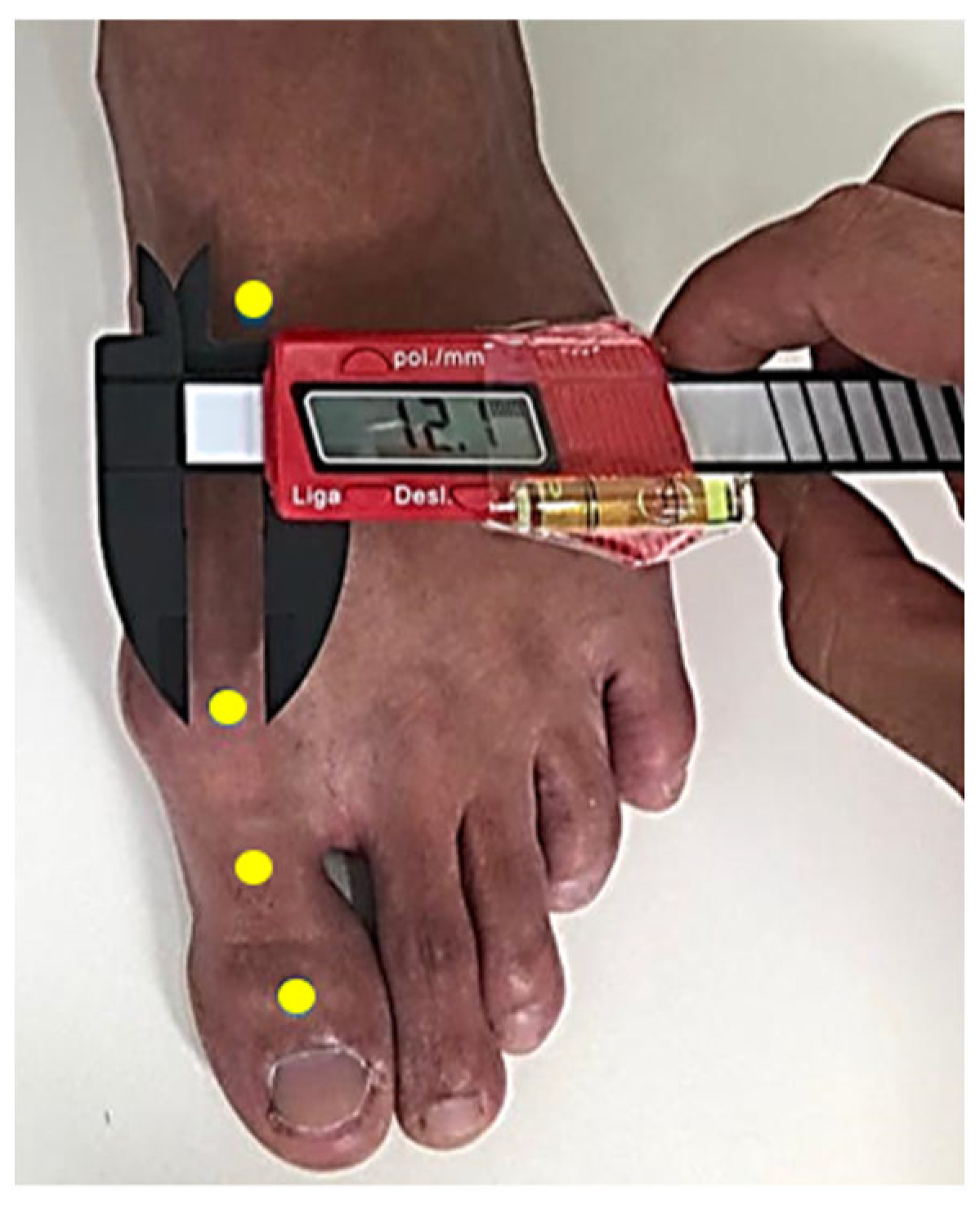A Pathway to Hallux Valgus Correction: Intra- and Interexaminer Reliability of Hallux Alignment
Abstract
1. Introduction
2. Materials and Methods
2.1. Participants and Inclusion Criteria
2.2. Stage of the Study, Procedures, and Tools
2.3. Hallux (Mis)Alignment Evaluation
2.4. Intra- and Interexaminer Reliability of Hallux (Mis)Alignment Assessment Procedures
2.5. Data Analysis
2.6. Samples and Participants
3. Results
Intra- and Interexaminer Reliability Results
- Situation A—after repeating all the procedures from fixing the adhesives to analyzing the images using Kinovea® software (with an interval of 5 up to 7 days);
- Situation B—assessment of hallux (mis)alignment using Kinovea® software based on previously saved images (with an interval of 14 days).
4. Discussion
5. Conclusions
Author Contributions
Funding
Institutional Review Board Statement
Informed Consent Statement
Data Availability Statement
Conflicts of Interest
References
- Kakwani, M.; Kakwani, R. Current concepts review of Hallux valgus. J. Arthrosc. Jt. Surg. 2021, 8, 222–230. [Google Scholar] [CrossRef]
- Piqué-Vidal, C.; Solé, M.T.; Antich, J. Hallux valgus Inheritance: Pedigree Research in 350 Patients With Bunion Deformity. J. Foot Ankle Surg. 2007, 46, 149–154. [Google Scholar] [CrossRef]
- McCluney, J.G.; Tinley, P. Radiographic Measurements of Patients with Juvenile Hallux valgus Compared with Age-Matched Controls: A Cohort Investigation. J. Foot Ankle Surg. 2006, 45, 161–167. [Google Scholar] [CrossRef]
- Coughlin, M.J.; Anderson, R.B. Hallus valgus. In Mann’s Surgery of the Foot and Ankle; Coughlim, M.J., Saltzman, C.L., Anderson, R.B., Eds.; Elsevier Saunders: Philadelphia, PA, USA, 2014; pp. 155–321. [Google Scholar]
- Menz, H.B.; Roddy, E.; Thomas, E.; Croft, P.R. Impact of Hallux valgus severity on general and foot-specific health-related quality of life. Arthritis Care Res. 2010, 63, 396–404. [Google Scholar] [CrossRef]
- Nix, S.; Smith, M.; Vicenzino, B. Prevalence of Hallux valgus in the general population: A systematic review and meta-analysis. J. Foot Ankle Res. 2010, 3, 21. [Google Scholar] [CrossRef]
- Menz, H.B.; Lord, S.R. Gait instability in older people with Hallux valgus. Foot Ankle Int. 2005, 26, 483–489. [Google Scholar] [CrossRef]
- Srivastava, S.; Chockalingam, N.; El Fakhri, T. Radiographic measurements of hallux angles: A review of current techniques. Foot 2010, 20, 27–31. [Google Scholar] [CrossRef] [PubMed]
- Garrow, A.P.; Papageorgiou, A.; Silman, A.J.; Thomas, E.; Jayson, M.I.V.; Macfarlane, G.J. The grading of Hallux valgus. The Manchester Scale. J. Am. Podiatr. Med. Assoc. 2001, 91, 74–78. [Google Scholar] [CrossRef] [PubMed]
- Jones, A.M.; Curran, S.A. Intrarater and interrater reliability of first metatarsophalangeal joint dorsiflexion: Goniometry versus visual estimation. J. Am. Podiatr. Med. Assoc. 2012, 102, 290–298. [Google Scholar] [CrossRef]
- Guzmán-Valdivia, C.H.; Blanco-Ortega, A.; Antonio Oliver-salazar, M.; Carrera Escobedo, J. Therapeutic Motion Analysis of Lower Limbs Using Kinovea. Int. J. Soft Comput. Eng. 2013, 3, 2231–2307. [Google Scholar]
- Coughlin, M.J.; Jones, C.P. Hallux valgus and first ray mobility: A prospective study. J. Bone Jt. Surg.-Ser. A 2007, 89, 1887–1898. [Google Scholar] [CrossRef]
- Torkki, M.; Malmivaara, A.; Seitsalo, S.; Hoikka, V.; Laippala, P.; Paavolainen, P. Surgery vs Orthosis vs Watchful Waiting for Hallux valgus: A randomized controlled trial. JAMA 2001, 285, 2474–2480. [Google Scholar] [CrossRef]
- Túlio Costa, M.; Zambelli De Almeida Pinto, R.; Ferreira, R.C.; Sakata, M.A.; Guilherme Frizzo, G.; Attílio, R.; Santin, L. Osteotomia da base do I metatarsal no tratamento do Hálux valgo moderado e grave: Resultados após seguimento médio de oito anos. Rev. Bras. Ortop. 2009, 44, 247–253. [Google Scholar] [CrossRef]
- du Plessis, M.; Zipfel, B.; Brantingham, J.W.; Parkin-Smith, G.F.; Birdsey, P.; Globe, G.; Cassa, T.K. Manual and manipulative therapy compared to night splint for symptomatic Hallux abducto valgus: An exploratory randomised clinical trial. Foot 2011, 21, 71–78. [Google Scholar] [CrossRef]
- Milachowski, K.A.; Krauss, A. Comparing radiological examinations between Hallux valgus night brace and a new dynamic orthosis for correction of the Hallux valgus. FuB Sprunggelenk. 2008, 6, 14–18. [Google Scholar] [CrossRef]
- Guimarães, C.; Teixeira-Salmela, L.; Rocha, I.; Bicalho, L.; Sabino, G. Fatores associados à adesão ao uso de palmilhas biomecânicas. Rev. Bras. Fisioter. 2006, 10, 271–277. [Google Scholar] [CrossRef]
- Davis, F.D. A Technology Acceptance Model for Empirically Testing New End-User Information Systems: Theory and Results. Doctoral Dissertation, Massachusetts Institute of Technology, Cambridge, MA, USA, 1985. [Google Scholar]
- Przysezny, W.L. Manual de Podoposturologia: Reorganização Neuro Músculo Articular Através da Estimulação dos Neurossensores Podais; Centro de Pesquisa em Podoposturologia da Podaly do Brasil: Brusque, Brazil, 2015. [Google Scholar]
- Eshraghi, S.; Esat, I.; Mohagheghi, A.A. Characterization of gait using plantar force transfer trajectory in individuals with Hallux valgus deformity. Gait Posture 2018, 62, 186–190. [Google Scholar] [CrossRef]
- Bddiman-Mak, E.; Conrad, K.J.; Roach, K.E. The foot function index: A measure of foot pain and disability. J. Clim. Epidemiol. 1991, 44, 561–570. [Google Scholar] [CrossRef]
- Martinez, B.R.; Staboli, I.M.; Kamonseki, D.H.; Budiman-Mak, E.; Yi, L.C. Validity and reliability of the Foot Function Index (FFI) questionnaire Brazilian-Portuguese version. Springerplus 2016, 5, 1810. [Google Scholar] [CrossRef] [PubMed]
- Cunha, F.V.M.; Rodrigues, T.A.A.; Alves, J.A.; Santos, J.D.M.; Martins, M.D.C.C. Inter-relationship between footprints and photogrammetry. Man. Ther. Posturol. Rehabil. J. 2016, 14, 381. [Google Scholar] [CrossRef]
- Iunes, D.H.; Castro, F.A.; Salgado, H.S.; Moura, I.C.; Oliveira, A.S.; Bevilaqua-Grossi, D. Confiabilidade intra e interexaminadores e repetibilidade da avaliação postural pela fotogrametria. Rev. Bras. Fisioter. 2005, 9, 327–334. [Google Scholar]
- Ribeiro, C.L.; Martins, M.N.; Amaro, L.L.D.M.; Pinto, S.A.; Barbosa, A.W.C.; De Souza, R.A.; Oliveira, M.X. Confiabilidade intra e interavaliador por fotogrametria para avaliação do ângulo poplíteo. ConScientiae Saúde 2012, 11, 438–445. [Google Scholar] [CrossRef]
- Oliveira De Araújo, E.; Duarte, A.D. Análise de confiabilidade de software na análise biomecânica: Revisão de literatura. Rev. Ação Ergonómica 2022, 15, e202202. [Google Scholar] [CrossRef]
- Carneiro, P.R.; da Silva Teles, L.C.; da Cunha, C.M.; dos Santos Cardoso, B. Intra- and inter-examiner reliability of the head postural assessment by computerized photogrammetry. Fisioter. Pesq. 2014, 21, 217–222. [Google Scholar] [CrossRef]
- Nix, S.; Russell, T.; Vicenzino, B.; Smith, M. Validity and reliability of Hallux valgus angle measured on digital photographs. J. Orthop. Sports Phys. Ther. 2012, 42, 642–648. [Google Scholar] [CrossRef]
- Yamaguchi, S.; Sadamasu, A.; Kimura, S.; Akagi, R.; Yamamoto, Y.; Sato, Y.; Sasho, T.; Ohtori, S. Nonradiographic measurement of Hallux valgus angle using self-photography. J. Orthop. Sports Phys. Ther. 2019, 49, 80–86. [Google Scholar] [CrossRef]
- Godoy, M.; Carvalho, F. Development of a new foot device for Hallux valgus correction: Preliminary results. In Ergonomics in Design; AHFE International: New York, NY, USA, 2022. [Google Scholar] [CrossRef]
- Cicchetti, D. V: Guidelines, criteria, and rules of thumb for evaluating normed and standardized assessment instruments in psychology. Psychol. Assess. 1994, 6, 284–290. [Google Scholar] [CrossRef]
- Furlan, L.; Sterr, A. The applicability of standard error of measurement and minimal detectable change to motor learning research—A behavioral study. Front. Hum. Neurosci. 2018, 12, 95. [Google Scholar] [CrossRef]
- do Paço, M.; Cruz, E.B. Fiabilidade Intra-Observador, Erro de Medida e Mudança Mínima Detectável do Weight-Bearing Lunge-Test e do Teste de Deslizamento Posterior do Astrágalo em Indivíduos com História de Entorse do Tornozelo. Ifisionline 2011, 2, 25–31. [Google Scholar]
- Portney, L.G.; Watkins, M.P. Foundations of Clinical Research: Applications to Practice; F. A. Davis Company: Philadelphia, PA, USA, 2015. [Google Scholar]
- Steffen, T.; Seney, M. Test-Retest reliability and minimal detectable change on balance and ambulation tests, the 36-Item short-form health survey, and the unified parkinson disease rating scale in people with parkinsonism. Phys. Therap. 2008, 88, 733–746. [Google Scholar] [CrossRef]
- Menz, H.B.; Munteanu, S.E. Radiographic validation of the Manchester scale for the classification of Hallux valgus deformity. Rheumatology 2005, 44, 1061–1066. [Google Scholar] [CrossRef] [PubMed]








| Situation | Sex (n) | Feet (n) | Age (n) | IMC | |||||
|---|---|---|---|---|---|---|---|---|---|
| F | M | Right | Left | Mean | Sd | Mean | Sd | ||
| Intrarater analysis | A | 6 | 4 | 10 | 10 | 48.4 | 13.34 | 21.48 | 1.73 |
| B | 13 | 7 | 10 | 10 | 39.15 | 15.37 | 24.24 | 3.15 | |
| Interrater analysis | A | 10 | 10 | 10 | 10 | 47.6 | 13.12 | 23.85 | 2.75 |
| B | 13 | 7 | 10 | 10 | 39.15 | 15.37 | 24.24 | 3.15 | |
| Test | Situation | Initial Evaluation | Final Evaluation | p-Value | ||
|---|---|---|---|---|---|---|
| Mean | Sd | Mean | Sd | |||
| Hallux (mis)alignment (degrees) | A | 21.92 | 4.55 | 22.04 | 4.91 | 0.249 |
| B | 22.44 | 4.72 | 22.48 | 4.74 | 0.795 | |
| Test | Situation | Examiner 1 | Examiner 2 | p-Value | ||
|---|---|---|---|---|---|---|
| Mean | Sd | Mean | Sd | |||
| Hallux (mis)alignment (degrees) | A | 21.92 | 4.55 | 22.49 | 3.91 | 0.387 |
| B | 22.44 | 4.72 | 22.52 | 4.32 | 0.841 | |
| Test | Situation | ICC | CI95% | |
|---|---|---|---|---|
| Hallux (mis)alignment (degrees) | Intraexaminer reliability | A | 0.998 | (0.994–0.999) |
| B | 0.995 | (0.988–0.998) | ||
| Interexaminer reliability | A | 0.871 | (0.680–0.949) | |
| B | 0.967 | (0.917–0.987) | ||
| Situation | SEM | CI95% | MDC95% | ||
|---|---|---|---|---|---|
| Hallux (mis)alignment (degrees) | Intraexaminer reliability | A | 0.20 | ±0.392 | 0.55° |
| B | 0.33 | ±0.65 | 0.91° | ||
| Interexaminer reliability | A | 1.63 | ±3.19 | 4.51° | |
| B | 0.86 | ±1.68 | 2.38° | ||
Disclaimer/Publisher’s Note: The statements, opinions and data contained in all publications are solely those of the individual author(s) and contributor(s) and not of MDPI and/or the editor(s). MDPI and/or the editor(s) disclaim responsibility for any injury to people or property resulting from any ideas, methods, instructions or products referred to in the content. |
© 2023 by the authors. Licensee MDPI, Basel, Switzerland. This article is an open access article distributed under the terms and conditions of the Creative Commons Attribution (CC BY) license (https://creativecommons.org/licenses/by/4.0/).
Share and Cite
Godoy, M.M.; Carvalho, F.; Moro, A.R. A Pathway to Hallux Valgus Correction: Intra- and Interexaminer Reliability of Hallux Alignment. Appl. Sci. 2023, 13, 7917. https://doi.org/10.3390/app13137917
Godoy MM, Carvalho F, Moro AR. A Pathway to Hallux Valgus Correction: Intra- and Interexaminer Reliability of Hallux Alignment. Applied Sciences. 2023; 13(13):7917. https://doi.org/10.3390/app13137917
Chicago/Turabian StyleGodoy, Marcos Marcondes, Filipa Carvalho, and Antônio Renato Moro. 2023. "A Pathway to Hallux Valgus Correction: Intra- and Interexaminer Reliability of Hallux Alignment" Applied Sciences 13, no. 13: 7917. https://doi.org/10.3390/app13137917
APA StyleGodoy, M. M., Carvalho, F., & Moro, A. R. (2023). A Pathway to Hallux Valgus Correction: Intra- and Interexaminer Reliability of Hallux Alignment. Applied Sciences, 13(13), 7917. https://doi.org/10.3390/app13137917







